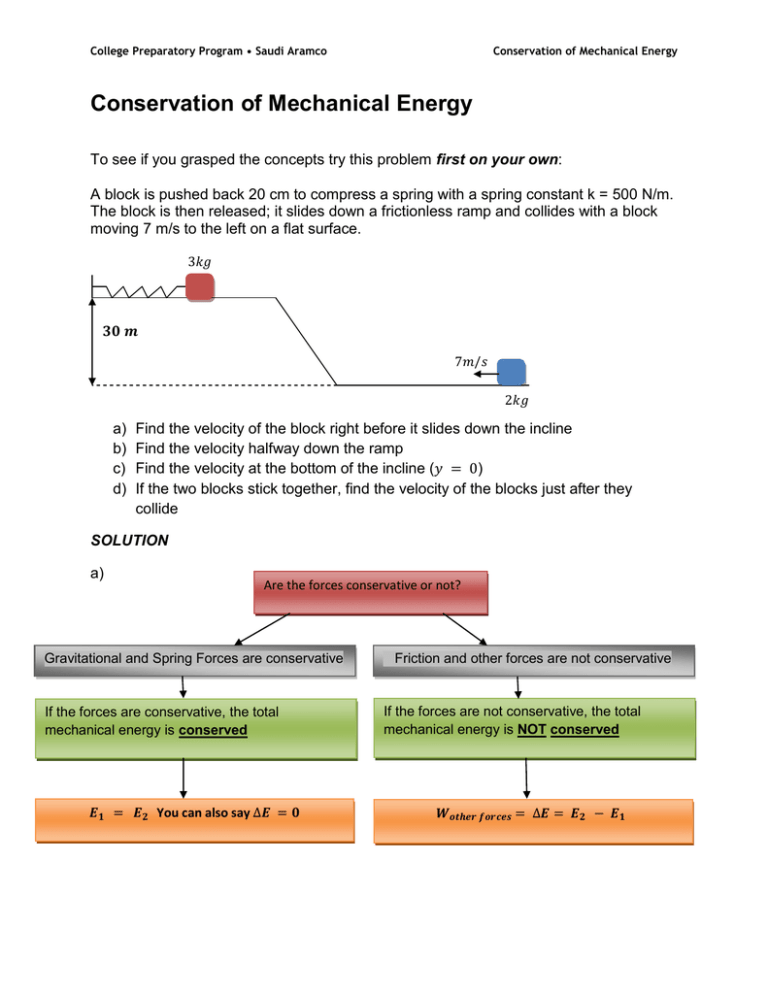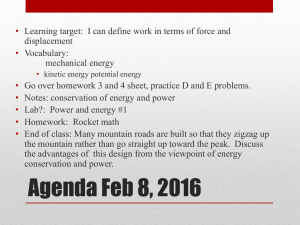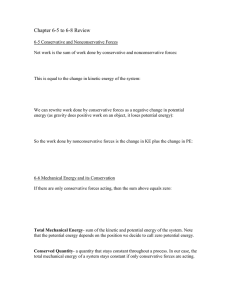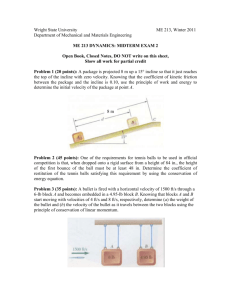Conservation of Mechanical Energy
advertisement

College Preparatory Program • Saudi Aramco Conservation of Mechanical Energy Conservation of Mechanical Energy To see if you grasped the concepts try this problem first on your own: A block is pushed back 20 cm to compress a spring with a spring constant k = 500 N/m. The block is then released; it slides down a frictionless ramp and collides with a block moving 7 m/s to the left on a flat surface. 3𝑘𝑔 𝟑𝟎 𝒎 7𝑚/𝑠 2𝑘𝑔 a) b) c) d) Find the velocity of the block right before it slides down the incline Find the velocity halfway down the ramp Find the velocity at the bottom of the incline (𝑦 = 0) If the two blocks stick together, find the velocity of the blocks just after they collide SOLUTION a) Are the forces conservative or not? Gravitational and Spring Forces are conservative If the forces are conservative, the total mechanical energy is conserved 𝑬𝟏 = 𝑬𝟐 You can also say ∆𝑬 = 𝟎 Friction and other forces are not conservative If the forces are not conservative, the total mechanical energy is NOT conserved 𝑾𝒐𝒕𝒉𝒆𝒓 𝒇𝒐𝒓𝒄𝒆𝒔 = ∆𝑬 = 𝑬𝟐 − 𝑬𝟏 College Preparatory Program • Saudi Aramco Conservation of Mechanical Energy Since there is no friction, you will use the concept of conservation of energy. All you need to do now is find the expressions of 𝐸1 and of 𝐸2 and balance them. E is the sum of potential 𝑈 and the kinetic energy 𝐾 𝐸 = 𝑈 + 𝐾 At the time of the release, what is the total mechanical energy𝐸1 ? 𝑈1 = 𝑈𝑠 + 𝑈𝑔 𝐾1 = 0 Released from rest so 𝑣 1 = 0 and 𝐾1 = 0 Elastic potential energy 𝑈𝑠 because the spring is compressed Gravitational potential energy 𝑈𝑔 1 𝑈𝑔 = 𝑚𝑔 𝑈𝑠 = 2k𝑥 2 Therefore: 1 𝐸1 = 2k𝑥 2 + 𝑚𝑔 Right before the block slides down the incline, what’s the total mechanical energy 𝐸2 ? 1 𝑈2 = 𝑈𝑔 = 𝑚𝑔 𝐾2 = 2 𝑚𝑣22 1 So 𝐸2 = 𝑚𝑔 + 2 𝑚𝑣22 College Preparatory Program • Saudi Aramco Conservation of Mechanical Energy Now balance the energies: 𝑬𝟏 = 𝑬𝟐 1 2 1 2 1 k𝑥 2 + 𝑚𝑔 = 𝑚𝑔 + 2 𝑚𝑣22 1 500(0.2)2 = 2 3𝑣22 It follows then that 𝑣2 = 2.58 𝑚/𝑠 Halfway down the ramp, what’s the total mechanical energy 𝐸3 ? b) 1 𝑈3 = 𝑈𝑔 = 𝑚𝑔(/2) 𝐾3 = 2 𝑚𝑣32 1 𝐸3 = 𝑚𝑔( ) + 𝑚𝑣32 2 2 Now balance the energies: you can use either 𝑬𝟑 = 𝑬𝟐 or 𝑬𝟑 = 𝑬𝟏 since all forces are conservative and the mechanical energy is conserved. 1 1 𝑚𝑔(2 ) + 2 𝑚𝑣32 = 𝑚𝑔 + 2 𝑚𝑣22 1 2 1 𝑚𝑣32 = 𝑚𝑔(2 ) + 2 𝑚𝑣22 𝑣32 = 𝑔 + 𝑣22 𝑣32 = 9.8 × 30 + 2.582 Yielding to 𝑣3 = 17.34 𝑚/𝑠 which is greater than 𝑣2 since more potential energy was transformed into kinetic energy! c) At the bottom of the incline, what’s the total mechanical energy 𝐸4 ? 𝑈4 = 0 1 𝐾4 = 2 𝑚𝑣42 No gravitational potential energy since 𝑦 = 0. Mechanical Energy is purely Kinetic College Preparatory Program • Saudi Aramco Conservation of Mechanical Energy 𝐸4 = 1 𝑚𝑣42 2 Now balance the energies: you can use either 𝑬𝟒 = 𝑬𝟑 or 𝑬𝟒 = 𝑬𝟐 or even 𝑬𝟒 = 𝑬𝟏 since all forces are conservative and the mechanical energy is conserved: 1 2 1 𝑚𝑣42 = 𝑚𝑔(2 ) + 2 𝑚𝑣32 𝑣42 = 𝑔 + 𝑣32 𝑣4 = 24.38 𝑚/𝑠 which is greater than 𝑣3 since all potential energy was transformed into kinetic energy! d) This is a collision question so you’ll need to use the concept of conservation of linear momentum. What is the total linear momentum of the system of the two blocks just before the collision? ′ 𝑃𝑏𝑒𝑓𝑜𝑟𝑒 = 𝑚1 𝑣𝑏𝑒𝑓𝑜𝑟𝑒 + 𝑚2 𝑣𝑏𝑒𝑓𝑜𝑟𝑒 Mass of Block 1; 𝑚1 = 3𝑘𝑔 Mass of Block 2; 𝑚2 = 2𝑘𝑔 Velocity of Block 1 just before the collision is 24.38 𝑚/𝑠 Velocity of Block 2 just before the collision is −7 𝑚/𝑠. The minus sign comes from the fact that Block 2 is moving in the opposite direction! College Preparatory Program • Saudi Aramco Conservation of Mechanical Energy 𝑃𝑏𝑒𝑓𝑜𝑟𝑒 = 3 × 24.38 − 2 × 7 = 59.14 𝑘𝑔. 𝑚/𝑠 What is the total linear momentum of the system of the two blocks just after the collision? 𝑃𝑎𝑓𝑡𝑒𝑟 = (𝑚1 + 𝑚2 )𝑣𝑎𝑓𝑡𝑒𝑟 The 2 Blocks stick together Common velocity of the 2 Blocks which became one object: inelastic collision 𝑃𝑎𝑓𝑡𝑒𝑟 = 5𝑣𝑎𝑓𝑡𝑒𝑟 𝑃𝑎𝑓𝑡𝑒𝑟 = 𝑃𝑏𝑒𝑓𝑜𝑟𝑒 5𝑣𝑎𝑓𝑡𝑒𝑟 = 59.14 𝑣𝑎𝑓𝑡𝑒𝑟 = 11.82 𝑚/𝑠 Now, here is an extra question to think about: is the kinetic energy of the system conserved or not? Why or why not? For a quick and efficient review of the concepts, click on the following: Mechanical Energy For more questions on conservation of energy visit, solve all the questions at: http://www.physics247.com/physics-homework-help/conservation-energy.php For the best resources go to: http://cpcapphysics.wikispaces.com/




